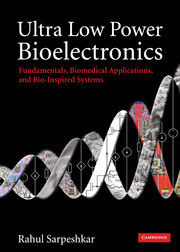Crossref Citations
This Book has been
cited by the following publications. This list is generated based on data provided by Crossref.
Yu, Theodore
and
Cauwenberghs, Gert
2010.
Analog VLSI Biophysical Neurons and Synapses With Programmable Membrane Channel Kinetics.
IEEE Transactions on Biomedical Circuits and Systems,
Vol. 4,
Issue. 3,
p.
139.
Wee, Keng Hoong
Turicc, Lorenzo
and
Sarpeshkar, Rahul
2010.
An Articulatory Speech-Prosthesis System.
p.
133.
Turicchia, Lorenzo
Do Valle, Bruno
Bohorquez, Jose L.
Sanchez, William R.
Misra, Vinith
Fay, Leon
Tavakoli, Maziar
and
Sarpeshkar, Rahul
2010.
Ultralow-Power Electronics for Cardiac Monitoring.
IEEE Transactions on Circuits and Systems I: Regular Papers,
Vol. 57,
Issue. 9,
p.
2279.
Wee, Keng Hoong
Turicchia, Lorenzo
and
Sarpeshkar, Rahul
2010.
A speech locked loop for cochlear implants and speech prostheses.
p.
1.
Grover, Pulkit
and
Sahai, Anant
2010.
Shannon meets Tesla: Wireless information and power transfer.
p.
2363.
Nageswaran, Jayram Moorkanikara
Richert, Micah
Dutt, Nikil
and
Krichmar, Jeffrey L
2010.
Towards reverse engineering the brain: Modeling abstractions and simulation frameworks.
p.
1.
Wattanapanitch, Woradorn
and
Sarpeshkar, Rahul
2011.
A Low-Power 32-Channel Digitally Programmable Neural Recording Integrated Circuit.
IEEE Transactions on Biomedical Circuits and Systems,
Vol. 5,
Issue. 6,
p.
592.
Im, Junha
Lee, Sangmin
and
Kim, Jaeseok
2011.
Design and implementation of a high data rate MICS digital baseband transmitter.
p.
13.
Wentz, Christian T
Bernstein, Jacob G
Monahan, Patrick
Guerra, Alexander
Rodriguez, Alex
and
Boyden, Edward S
2011.
A wirelessly powered and controlled device for optical neural control of freely-behaving animals.
Journal of Neural Engineering,
Vol. 8,
Issue. 4,
p.
046021.
Gervais, Luc
de Rooij, Nico
and
Delamarche, Emmanuel
2011.
Microfluidic Chips for Point‐of‐Care Immunodiagnostics.
Advanced Materials,
Vol. 23,
Issue. 24,
Mathews, M Alex
2011.
Diode Lasers: A Versatile Clinical Tool (A Technical and Clinical Review).
International Journal of Laser Dentistry,
Vol. 1,
Issue. 1,
p.
9.
Im, Junha
Jung, Yunho
Lee, Seongjoo
and
Kim, Jaeseok
2011.
High-speed multicarrier transmission scheme for implantable medical devices.
IEICE Electronics Express,
Vol. 8,
Issue. 3,
p.
143.
Wang, Peijun
Tang, Yina
Geng, Kunling
Wang, Guoxing
Deng, Simin
Shen, Guofang
Rui, Yuefeng
and
Liu, Jingquan
2011.
Implantable wireless power receiver with self-displayed power meter.
p.
1114.
Zhu, Xiaowei
Vasanth, Karthik
Xu, Xiaochen
Smyth, Charles
and
Rhoton, Brent
2011.
Application based reliability assessment and qualification methodology for medical ICs.
p.
3B.4.1.
Perdikis, Dionysios
Huys, Raoul
Jirsa, Viktor K.
and
Bassett, Danielle S.
2011.
Time Scale Hierarchies in the Functional Organization of Complex Behaviors.
PLoS Computational Biology,
Vol. 7,
Issue. 9,
p.
e1002198.
Seth, Sachin
Najafizadeh, Laleh
and
Cressler, John D.
2011.
On the RF Properties of Weakly Saturated SiGe HBTs and Their Potential Use in Ultralow-Voltage Circuits.
IEEE Electron Device Letters,
Vol. 32,
Issue. 1,
p.
3.
Do Valle, Bruno
Wentz, Christian T.
and
Sarpeshkar, Rahul
2011.
An Area and Power-Efficient Analog Li-Ion Battery Charger Circuit.
IEEE Transactions on Biomedical Circuits and Systems,
Vol. 5,
Issue. 2,
p.
131.
Wee, Keng Hoong
Turicchia, Lorenzo
and
Sarpeshkar, Rahul
2011.
An Articulatory Silicon Vocal Tract for Speech and Hearing Prostheses.
IEEE Transactions on Biomedical Circuits and Systems,
Vol. 5,
Issue. 4,
p.
339.
Hu, Yuanqi
Liu, Yan
Constandinou, Timothy G.
and
Toumazou, Christofer
2011.
A 5s-time-constant temperature-stable integrator for a tuneable PID controller in LOC applications.
p.
1387.
Goodarzy, F.
and
Skafidas, E.
2011.
A 20 pJ/b (10 µW) digital receiver based on a new modulation (SAS) for retinal prosthesis application.
p.
393.





